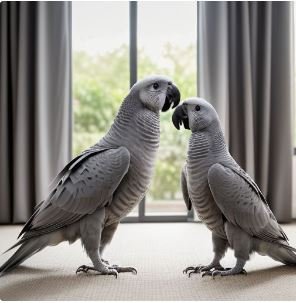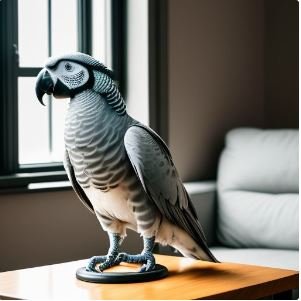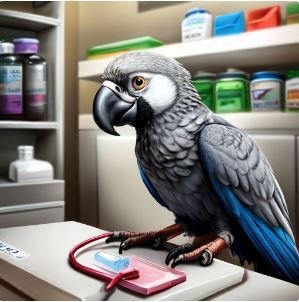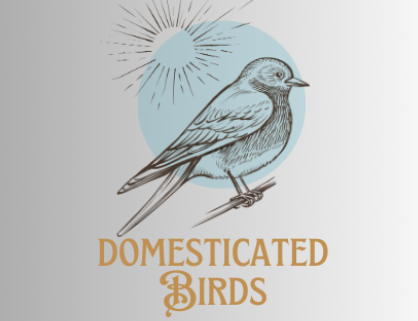Importance of Understanding African Grey Parrot Age Expectancy
African Grey Parrots are among the most beloved and intelligent bird species, captivating enthusiasts with their exceptional cognitive abilities and charming personalities. However, ensuring the longevity and well-being of these magnificent creatures requires a deep understanding of various factors that influence their age expectancy.
In this article, we delve into the intricacies of African Grey Parrot age expectancy, shedding light on the disparities between wild and captive environments, exploring influential factors, addressing common health issues, highlighting owner mistakes to avoid, providing actionable tips for extending lifespan, and sharing stories of remarkable longevity. Let’s embark on a journey to enhance the lives of our feathered companions.
African Grey Parrot Age Expectancy: In the Wild vs. Captivity
Natural Habitat and Lifespan
In their native habitats of Central and West Africa, African Grey Parrots thrive in lush forests, where they exhibit complex social behaviors and forage for a diverse array of fruits, nuts, seeds, and vegetation. Despite facing threats from habitat loss and poaching, these birds can live up to 50-60 years in the wild, benefiting from the natural balance of their ecosystem.
Lifespan in Captivity: Challenges and Advantages
In captivity, African Grey Parrots face a range of challenges and advantages that significantly influence their lifespan. On average, these intelligent birds can live anywhere from 40 to 60 years under human care, with individual variation based on factors such as diet, environment, and healthcare.

One of the foremost challenges is ensuring a balanced and nutritious diet, as captive parrots may lack access to the diverse array of foods available in their natural habitat. Without proper nutrition, they are susceptible to health issues like obesity and nutritional deficiencies, which can shorten their lifespan. Additionally, the confined space and limited environmental stimuli in captivity can lead to stress, boredom, and behavioral problems if not adequately addressed. These factors underscore the importance of providing enrichment activities, social interaction, and mental stimulation to promote overall well-being and longevity.
Despite these challenges, captivity offers advantages such as consistent access to veterinary care, nutritional monitoring, and control, and an enriched environment.
Factors Influencing African Grey Parrot Age Expectancy
Several factors play a crucial role in determining African Grey Parrots age expectancy, encompassing genetic predisposition, environmental conditions, diet, and social interaction. Understanding these factors is essential for maximizing the lifespan and well-being of these intelligent birds.
Genetic Predisposition
Genetics significantly influence an African Grey Parrot age expectancy, with certain individuals inheriting longevity traits from their parents. For example, parrots from bloodlines with a history of robust health and longevity are more likely to live longer than those with genetic predispositions to specific health conditions.
Genetic diversity within captive breeding populations can impact overall health and resilience to disease, affecting lifespan.
Environmental Conditions
The environment in which an African Grey Parrot lives plays a pivotal role in its age expectancy. Factors such as temperature, humidity, air quality, and exposure to natural light can profoundly impact health and African grey parrot age expectancy.
For instance, parrots kept in environments with poor ventilation or high levels of pollutants may be more susceptible to respiratory issues, which can shorten their lifespan.
Conversely, providing an enriched environment with opportunities for physical activity, mental refreshment, and social interaction can promote longevity and overall health.

Diet and Nutrition
A balanced and nutritious diet is essential for maintaining optimal health and extending the lifespan of African Grey Parrots. A diet rich in a variety of fresh fruits, vegetables, nuts, seeds, and formulated pellets provides essential vitamins, minerals, and nutrients necessary for proper growth, development, and immune function.
Don’t worry, a complete diet plan is given in the next few paragraphs.
Social Interaction and Mental Stimulation
African Grey Parrots are highly social creatures that thrive on interaction and mental excitement. Adequate socialization with both humans and compatible avian companions is crucial for preventing loneliness, boredom, and associated behavioral issues.
For example, parrots provided with regular opportunities for social interaction, play, and enrichment activities exhibit lower stress levels and better overall health, contributing to a longer lifespan.
Similarly, mental Excitement through puzzle toys, foraging activities, and training exercises helps keep the parrot’s mind active and engaged, reducing the risk of cognitive decline and age-related issues.
Healthcare and Veterinary Intervention
Regular veterinary check-ups, preventive care, and prompt medical intervention are vital for maintaining the health and longevity of African Grey Parrots. Early detection and treatment of health issues, such as respiratory infections, feather plucking, and viral diseases, can prevent complications and improve prognosis.
Proactive measures such as vaccination, parasite control, and routine health monitoring contribute to overall well-being and longevity. Owners who prioritize preventive healthcare and promptly address any signs of illness or discomfort can significantly extend their parrot’s lifespan.
Common Mistakes That Lead to Decrease African Grey Parrot Age Expectancy
Neglecting Proper Nutrition
Poor dietary choices, such as offering high-fat treats or human foods high in salt and sugar, can contribute to obesity, nutritional deficiencies, and shortened lifespan.
Lack of Mental and Physical Excitement
Boredom and lack of environmental enrichment can lead to behavioral problems, obesity, and decreased lifespan in African Grey Parrots.
Exposure to Toxins and Hazardous Materials
Ingestion or inhalation of toxic substances found in household items, such as cleaning products, pesticides, and lead-based materials, can have severe and potentially fatal consequences for African Grey Parrots.
Improper Cage Conditions
Inadequate cage size, poor hygiene, and inappropriate placement can contribute to stress, respiratory problems, and decreased African Grey Parrot age expectancy.

Overlooking Emotional Well-being
Failure to address emotional needs, such as socialization, mental stimulation, and positive reinforcement training, can lead to loneliness, anxiety, and shortened lifespan.
Misinterpreting Signs of Illness or Aging
Lack of awareness or misinterpretation of signs indicating illness or aging can delay necessary medical intervention, exacerbating health issues and reducing lifespan.
Tips for Extending the Age Expectancy of Your African Grey Parrot
Balanced Diet Recommendations
Offer a diverse array of fresh fruits, vegetables, nuts, seeds, and formulated pellets to meet nutritional needs and promote overall health and longevity.
Proper Diet Plan for African Grey Parrots:
1. Pelleted Diet:
Offer high-quality commercial pellets specifically formulated for African Grey Parrots. These pellets provide essential nutrients and vitamins necessary for optimal health.
Quantity:
Offer approximately 1/2 to 3/4 cup commercial pellets per day.
2. Fresh Fruits and Vegetables:
- Dark leafy greens (e.g., kale, spinach)
- Bell peppers
- Carrots
- Broccoli
- Apples
- Berries
Rich in vitamins, antioxidants, and fiber, supports immune function, digestion, and overall well-being. Rotate the selection to ensure a diverse range of nutrients and flavors.
Quantity:
1/2 to 1 cup of fresh fruits and vegetables daily, chopped into small, bite-sized pieces.

3. Healthy Seeds and Nuts:
- Sunflower seeds
- Pumpkin seeds
- Almonds
- Walnuts
Healthy Seeds and Nuts promote skin and feather health. Limit the quantity to prevent overconsumption and potential weight gain.
Quantity:
1-2 tablespoons per day, as they are high in fat and calories.
4. Whole Grains:
- Brown rice
- Quinoa
- Whole wheat pasta
These grains provide fiber and complex carbohydrates for energy.
Quantity:
1/4 to 1/2 cup of cooked whole grains.
5. Calcium and Protein Sources:
- Cuttlebone
- Calcium-rich vegetables (e.g., broccoli)
- Commercial calcium supplements (if recommended by a veterinarian)
protein sources:
- Cooked chicken or turkey (without seasoning)
- Hard-boiled eggs (occasionally)
Essential for bone health, muscle development, and overall growth, ensuring strong skeletal structure and tissue repair.
Quantity:
Offer calcium-rich foods in small amounts.
6. Limit Treats:
Avoid offering high-fat, sugary, or salty human foods, as they can contribute to obesity and health problems.
Limit treats to small portions of healthy fruits, vegetables, seeds, or nuts as occasional rewards.
7. Fresh Water:
Ensure access to clean, fresh water at all times to prevent dehydration and promote overall health.
8. Supplementation:
Consider supplementing their diet with avian-specific multivitamins and mineral supplements as recommended by a veterinarian.
Exercise and Enrichment Activities
1. Physical Exercise:
- Encourage your parrot to engage in physical activities such as flying, climbing, and playing with toys.
- Provide a variety of perches of different sizes and textures to promote foot health and encourage movement.
- Consider setting up a play gym or bird-safe branches in their environment to encourage natural behaviors like hopping and exploring.
2. Mental enrichment:
- Offer interactive toys, puzzles, and foraging activities that challenge your parrot’s problem-solving skills and keep them mentally engaged.
- Rotate toys regularly to prevent boredom and maintain interest.
- Hide treats or favorite toys inside foraging toys to encourage exploration and provide rewards for effort.
3. Environmental Enrichment:
- Create a stimulating environment by introducing new toys, objects, and perches regularly.
- Provide opportunities for natural behaviors such as shredding, chewing, and exploring by offering safe, bird-friendly materials like paper, cardboard, and untreated wood.
- Place the cage in a central location in your home where your parrot can observe household activities and interact with family members.
4. Socialization and Bonding
Socialization and bonding are essential aspects of caring for an African Grey Parrot, as they are highly social and intelligent birds that thrive on interaction and companionship. Here are some tips to foster positive social interactions, bonding opportunities, and enrichment activities for your parrot:

- Human Interaction:
Spend quality time with your parrot every day, engaging in activities such as talking, singing, and training.
Offer treats as rewards for good behavior during training sessions to strengthen the bond between you and your parrot.
Encourage interactive play by using toys and props that stimulate natural behaviors and encourage physical activity.
- Avian Companionship:
If possible, consider providing a compatible avian companion for your parrot to interact with.
Introduce new birds gradually and under supervision to ensure they get along well and to prevent conflicts.
Provide separate cages and resources to prevent territorial disputes and promote harmonious cohabitation.
- Other Activities:
Arrange playdates with other parrot owners or participate in avian socialization groups to provide opportunities for your parrot to interact with other birds.
Organize outings or trips to bird-friendly locations such as pet stores or outdoor aviaries to expose your parrot to new sights, sounds, and experiences.
Incorporate enrichment activities such as training sessions, puzzle-solving games, and outdoor adventures to keep your parrot mentally stimulated and emotionally fulfilled.
DO’s and DON’Ts for Maximizing Your African Grey Parrot age expectancy:
So, after all this discussion we can make a list of do’s and don’ts for us:
DO’s:
- Provide a Balanced Diet: Offer a variety of nutritious foods to support optimal health.
- Encourage Physical Activity: Promote regular exercise and out-of-cage time for physical fitness.
- Stimulate Mental Engagement: Offer enrichment activities and social interactions to keep the parrot mentally sharp.
- Foster Socialization: Encourage positive interactions with humans and other birds to prevent loneliness.
- Regularly Monitor Health: Schedule routine veterinary check-ups and promptly address any health concerns.
DON’Ts:
- Overfeed High-Fat Treats: Limit fatty treats to prevent obesity and related health issues.
- Neglect Exercise: Ensure adequate physical activity to prevent obesity and muscle atrophy.
- Ignore Behavioral Cues: Pay attention to changes in behavior as they may indicate underlying health or emotional issues.
- Skimp on Veterinary Care: Invest in regular veterinary check-ups and prompt medical attention for any health concerns.
- Isolate Your Parrot: Provide opportunities for social interaction and mental stimulation to prevent loneliness and boredom.
Mortality Causes in Captivity
In captivity, African Grey Parrots are susceptible to various health risks and environmental hazards that can shorten their lifespan, including:
Respiratory Infections and Diseases:
Poor ventilation and exposure to airborne pathogens can lead to respiratory issues, such as pneumonia, bronchitis, and sinus infections.
Malnutrition and Dietary-Related Issues:
Inadequate nutrition, including deficiencies in essential vitamins and minerals, can weaken the immune system and contribute to a range of health problems.
Traumatic Injuries from Cage Accidents:
Improperly designed or cluttered cages can increase the risk of falls, collisions, and entrapment, resulting in serious injuries or even death.
Psittacine Beak and Feather Disease (PBFD):
This viral infection attacks the feathers, beak, and immune system, leading to feather loss, deformities, and increased susceptibility to secondary infections.
Heart Disease and Organ Failure:
Factors such as obesity, poor diet, and genetic predisposition can contribute to heart disease and organ failure, resulting in premature death.

Age-Related Complications:
As African Grey Parrots age, they become more susceptible to age-related health issues such as arthritis, cataracts, and degenerative diseases.
Accidental Poisoning from Household Substances:
Exposure to toxic substances commonly found in households, such as cleaning products, pesticides, and certain plants, can lead to poisoning and fatal consequences.
Stress-Related Disorders Due to Improper Environment:
Inadequate housing conditions, lack of socialization, and environmental stressors can trigger stress-related disorders such as feather plucking, self-mutilation, and behavioral abnormalities.
Neglect or Inadequate Care:
Failure to provide proper husbandry, veterinary care, and attention to the parrot’s physical and emotional needs can result in neglect-related health issues and a shortened lifespan.
Behavioral Problems Leading to Self-Harm:
Boredom, loneliness, and lack of mental stimulation can manifest in destructive behaviors such as feather plucking, excessive screaming, and self-injury, posing serious risks to the parrot’s well-being.
Stories of Remarkable Longevity
Story 1: A parrot named Charlie lived to be 55 years old, astonishing his owner with his intelligence and affectionate nature.
The owner remarked, “Charlie was more than just a pet; he was a cherished member of our family. His playful antics and vocal repertoire brought joy to our lives every day.”
Advice: “Invest time in building a strong bond with your parrot through positive reinforcement training and interactive play. It fosters trust and enriches both your lives.”
Story 2: Maya, a rescue African Grey Parrot, defied the odds by thriving for over 40 years despite a challenging past.
Her owner shared, “Maya taught me resilience and the importance of providing love and stability to birds in need. Despite her traumatic past, she blossomed into a confident and affectionate companion.”
Advice: “Adopting a rescue parrot can be immensely rewarding, but it requires patience, understanding, and a commitment to providing a nurturing environment.”
Conclusion:
Reflecting on the enigmatic longevity of African Grey Parrots underscores the significance of proactive care, environmental enrichment, and responsible ownership in maximizing their lifespan. By understanding the intricacies of African Grey Parrots age expectancy, addressing health challenges, and fostering emotional well-being, owners can empower themselves to enhance the lives of their beloved pets, ensuring years of companionship and joy.
FAQs:
What are some common health issues African Grey Parrots face?
Common health issues include respiratory infections, feather plucking, psittacine beak and feather disease (PBFD), and nutritional deficiencies.
How can I ensure my African Grey Parrot lives a long and healthy life?
Provide a balanced diet, regular exercise, mental stimulation, socialization, and veterinary care while avoiding common pitfalls such as neglecting nutrition and ignoring behavioral cues.
Are there specific environmental factors that can impact my parrot’s lifespan?
Yes, factors like proper cage conditions, exposure to toxins, adequate mental stimulation, and social interaction significantly influence a parrot's well-being and longevity.
What should I do if I suspect my African Grey Parrot is unwell?
Contact a qualified avian veterinarian immediately for a thorough evaluation and treatment. Early intervention is crucial in addressing health issues and preserving lifespan.
What factors can shorten an African Grey Parrot’s lifespan?
Poor nutrition, inadequate veterinary care, exposure to toxins, stress from improper environment, and lack of mental and physical stimulation.
Are there any specific dietary requirements to promote longevity?
Yes, providing a balanced diet rich in essential nutrients, including vitamins, minerals, and antioxidants, can promote longevity in African Grey Parrots. Incorporating a variety of fresh fruits, vegetables, lean protein sources, and fortified pellets can support overall health and enhance the parrot's lifespan
Are there any lifestyle changes I should make to accommodate my aging African Grey Parrot?
Yes, consider adjusting your African Grey Parrot's living environment by providing easier access to perches, food, and water to accommodate any mobility or vision changes. Additionally, you can read this complete article for tailored recommendations on diet, exercise, and enrichment activities to support your parrot's aging needs.
What role does mental stimulation play in extending an African Grey Parrot’s lifespan?
Mental stimulation plays a crucial role in extending an African Grey Parrot's lifespan by keeping their cognitive abilities sharp, preventing boredom-induced behaviors, and promoting overall mental well-being, contributing to a healthier and happier life for the parrot.
How can I create a suitable environment for my African Grey Parrot to thrive as they age?
To create a suitable environment for your aging African Grey Parrot, ensure vast space for movement, provide a variety of mentally stimulating toys, and maintain a consistent routine to minimize stress and promote overall well-being. Regular veterinary check-ups and a balanced diet tailored to their changing needs are also essential for their health and longevity.


2 thoughts on “Factors effecting African Grey Parrot Age Expectancy: Expert Strategies to improve it.”